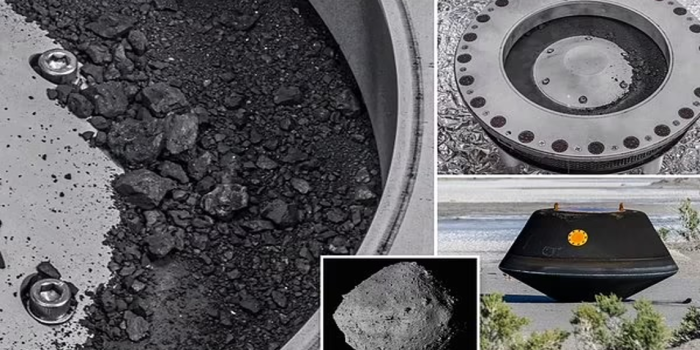NASA recently unveiled a remarkable discovery from a sealed capsule that returned to Earth last month. This capsule contained a carbon-rich soil sample collected from the surface of the near-Earth asteroid Bennu by the OSIRIS-REx spacecraft. The event, which took place at NASA’s Johnson Space Center in Houston, marked the culmination of a seven-year joint mission between NASA and the University of Arizona, providing insights into the origins of our solar system and life on Earth.
The return capsule’s landing in the Utah desert represented a monumental achievement, making it only the third asteroid sample, and the largest to date, to be brought back to Earth for examination. The unveiling of the material revealed a fascinating glimpse into the distant past of our universe. NASA chief Bill Nelson marveled at the significance of the moment as the first images were displayed, describing the retrieved material as “a celestial artifact about 4.5 billion years old.”

The initial image showcased a collection of charcoal-colored rocks, pebbles, and dust found in the outer part of the sample-collection assembly. These remnants were what remained after the asteroid’s soil passed through a filter into the spacecraft’s storage canister. While the inner science canister containing the bulk of the specimen is still being carefully disassembled, scientists immediately turned their attention to the “bonus” sample of overflow material.
Upon examination with electron microscopes and X-ray instruments, researchers made several exciting discoveries. The material contained a significant amount of carbon, approximately 5% by weight, a crucial element for life on Earth. Furthermore, water molecules were identified locked within the crystallized structure of clay fibers, suggesting a water-rich environment during the material’s formation. Iron minerals, in the form of iron sulfides and iron oxides, were also detected, further indicating the presence of water during the material’s early history.

Daniel Glavin, a senior sample scientist at NASA’s Goddard Space Flight Center, noted that early analysis suggested the material was “loaded with organics.” These findings could potentially bolster the hypothesis that the Earth’s early existence was influenced by the delivery of essential components for life by celestial objects such as comets, asteroids, and meteorites.
Bennu, discovered in 1999, is characterized as a loose collection of rocky material, held together by gravity, and offers valuable insights into the early solar system. Its unaltered chemistry and mineralogy since its formation make it a vital resource for studying astrobiology and developing rocky planets like Earth.

Initially inspected in Utah, the capsule was transported to Houston for a more detailed examination in a specially designed “clean room” within the Johnson Space Center’s astromaterials curation facility. In the coming months, the asteroid sample will be divided into smaller specimens and distributed to around 200 scientists in 60 laboratories worldwide. The estimated weight of the Bennu sample upon landing was approximately 250 grams, surpassing the 60-gram minimum target. A more precise measurement will be determined once the canister is fully opened and the contents are weighed.

The OSIRIS-REx mission, which launched in 2016 and reached Bennu in 2018, has provided an exciting opportunity to learn more about our solar system’s origins. As this mission concludes, NASA is preparing to embark on another journey to a distant asteroid named Psyche, a metal-rich body believed to be a protoplanet’s remnant core.
All in all, the recent unveiling of the carbon-rich asteroid sample provides valuable insights into the formation of our solar system and the potential for life beyond Earth. These discoveries underscore the importance of space exploration in unlocking the mysteries of our universe.


